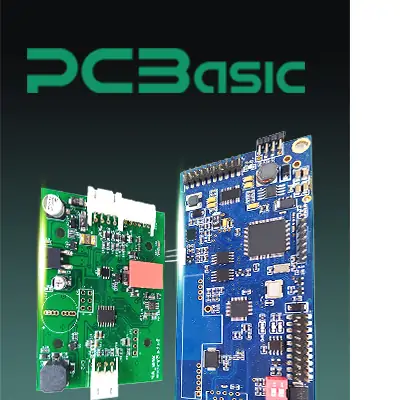

Global high-mix volume high-speed PCBA manufacturer
9:00 -18:00, Mon. - Fri. (GMT+8)
9:00 -12:00, Sat. (GMT+8)
(Except Chinese public holidays)


Global high-mix volume high-speed PCBA manufacturer
9:00 -18:00, Mon. - Fri. (GMT+8)
9:00 -12:00, Sat. (GMT+8)
(Except Chinese public holidays)
The miniaturization of
electronic devices is advancing rapidly. Signal integrity, system cost,
and reliability are becoming major challenges for engineers. To meet the
ever-growing requirements of the miniaturization of electronic devices, the rigid-flex
PCB solution is becoming popular.
As the name implies, flexible circuit boards introduce flexibility and bendability in electronic boards. The terms “rigid” and “flex” imply that the circuit board has rigid and flex regions, making them suitable for a wide range of applications, particularly in aerospace and military applications. The use of flexible circuit boards eliminates the traditional wiring connections. The flexibility and bendability of circuit boards are primarily made using polyimide material instead of FR4, which is used only in rigid PCBs. The flexibility of these circuit boards allows them to fit into complex shapes and spaces, making them ideal for military applications, aerospace, wearable electronics, cameras, and smartphones.
This article will help you to understand and learn the rigid-flex PCB manufacturing process, its design, and cost considerations. Whether you are an expert or a beginner, this guide will ready you to kick-start your rigid-flex PCB.
Rigid-flex PCBs are a type of circuit board that combines the advantages of both rigid and flex circuit boards and offers a high level of bendability and tensile strength. This makes them a popular choice in applications such as medical devices, military applications, aerospace, cameras, and smartphones. Their flexibility gives the user the freedom to fit them in complex packaging geometry with precision and accuracy.
Mostly, polyimide material is used to achieve flexibility. The polyimide material properties offer a higher degree of flexibility as compared to the standard FR4 material, which is used in traditional rigid PCBs. The dielectric constant, or simply Dk value, of polyimide material, is between 3.0 and 3.5, which is better compared to FR4 material, which has 3.5 and 4.0. Commonly used polyimide materials for rigid-flex PCBs are Nelco and Rogers. For only flex PCBs, Kapton is generally preferred.
The rigid-flex PCBs are generally categorized into single-sided
rigid-flex PCBs, double-sided rigid-flex PCBs, and multilayer rigid-flex PCBs.
1. Single-Side Rigid-flex PCB: The single-sided rigid-flex PCB is the basic among all types. These circuit boards consist of a single conducting layer on a flex substrate. Holes are drilled through the substrate to enable the components to pass through during the soldering process. A coverlay made from polyimide is commonly used to protect the circuit board from the harsh environment.
2. Double-Side Rigid-flex PCB: These rigid-flex circuit boards consist of two conducting layers. The plated through holes are drilled to make the electrical connection between layers.
3. Multilayer Rigid-flex PCB: Unlike a double-sided rigid-flex PCB, a multilayer rigid-flex PCB consists of more than two conducting layers. The Plated Through Holes (PTH) are drilled to make the electrical connections between multilayers. These circuit boards are complex in design compared to other rigid-flex PCBs, but they are considered an effective solution in situations where crosstalk issues, high component density, and impedance requirements are desired.
 About PCBasic
About PCBasic
Time is money in your projects – and PCBasic gets it. PCBasic is a PCB assembly company that delivers fast, flawless results every time. Our comprehensive PCB assembly services include expert engineering support at every step, ensuring top quality in every board. As a leading PCB assembly manufacturer, we provide a one-stop solution that streamlines your supply chain. Partner with our advanced PCB prototype factory for quick turnarounds and superior results you can trust.
Rigid-flex PCBs have many unique benefits over traditional rigid PCBs. These circuit boards are designed to fit into complex geometries and to achieve a high degree of reliability.
1. Rigid-flex boards are often used in military applications where they must withstand harsh environmental conditions. The polyimide material used in rigid-flex boards covers the conductors and protects the circuit board from harsh environmental conditions.
2. Space becomes a crucial factor in applications like aerospace and defense, where compactness and lightweight are required. The rigid-flex PCBs’ ability to fit into any shape enables them to save space and make them lightweight.
3. In
defense applications, circuit boards are more prone to high vibrational shocks,
like aircraft. Rigid-flex circuit boards’ ability to bend and flex enables them
to absorb high vibrational shocks.
4. As compared to traditional rigid PCBs, rigid-flex PCBs can be reinstalled without being damaged. Typically, a static rigid-flex PCB can be bending cycles or bent 100 times.
5. The rigid-flex circuit boards give the designers creative freedom to make 3D shapes and many different shapes. The different and complex shapes are often required in applications like fitness equipment and wearable health monitoring equipment.
6. The ability of rigid-flex PCBs to flex and bend without breaking enables them to absorb mechanical and vibrational shocks. This makes them more reliable and durable compared to traditional rigid circuit boards.
The modern electronics demand compact and smart devices that bring the rigid-flex PCB into the game. The rigid-flex PCBs were initially used by the military industry to make reliable and lightweight products. In current days, rigid-flex PCBs are widely used in nearly every industry.
1. Medical Devices: Rigid-flex PCBs are used in medical devices that require compactness and smartness, such as flexible sensors and wearable monitoring devices. Cardiac devices are becoming sophisticated and smart, such as pacemakers. These devices contain a flex circuit to achieve compactness, are lightweight, and are reliable.
2. Consumer Electronics: Rigid-flex PCBs are increasingly being used in consumer electronics due to their ability to fit into complex spaces like computers, laptops, smartphones, and cameras.
3. Aerospace Industry: The aerospace industry requires rugged, compact, and lightweight devices that can survive the harsh environmental conditions. Rigid-flex circuit boards fulfil these needs and are widely used in a wide range of aerospace applications such as aircraft, drones, avionics, and space mission devices. The NASA Mars rover also uses the rigid-flex circuit boards, which are around 140 million miles away from Earth.
4. Military Applications: Rigid-flex circuit boards are used in military applications where space, weight, system reliability, and performance are critical parameters, such as missiles, fighter jets, military radios, and surveillance payloads.
5. Automotive Industry: The advancements in the automotive industry are increasing rapidly, such as the invention of automatic driving cars. These advanced vehicles use rigid-flex circuit boards for their control panels and internal wiring systems.
6. Robotics: The rise of AI and the development of autonomous and self-decision-making robots demand a more reliable circuit board. The rigid-flex PCBs achieve benchmarks to fit into complex spaces and are increasingly being used in the field of robotics.
When designing the rigid-flex PCBs, it is important to carefully consider some design parameters such as bending radius, thickness of material, and mechanical stresses, etc.
1. Calculate Bend Radius: It is important to calculate the bend radius for your rigid-flex PCB to ensure flexibility without damage. Bend radius is basically the measurement of the degree to which a flex area of a circuit board can be easily bent. The correct calculation of bend radius for your rigid-flex PCB ensures that the PCB can survive the required number of bends.
|
Number of Layers |
Bend Radius |
|
1 or single side only |
Thickness in mm x 6 |
|
2 or two-sided |
Thickness in mm x 12 |
|
3 or multilayer board |
Thickness in mm x 24 |
2. Number of Times of Flexibility: Before starting the PCB design, determine the number of times a PCB will be flexed. This gives you an idea of whether you design a static rigid-flex PCB or a dynamic rigid-flex PCB.
3. It is recommended to choose polyimide material for the flex part of the PCB and FR4 for the rigid section.
4. It is recommended that Plated Through Holes (PTH) should always be at least 0.5mm away from the bend area.
5. Always avoid 90° of bending. The perpendicular pending can cause the board to break.
6. Do not use Plated Through Holes on the flexible part or near the bending area of the flexible section.
7. Rigid-flex PCBs are more prone to heat, and this can damage the PCB. So, proper thermal management is important to avoid any overheating of the PCB.
8. PCB stack-up plays an important role in determining the accuracy of the circuit board. Multilayer Rigid-flex PCBs have more than two conductive layers. The proper alignment of conductive layers ensures signal integrity and enhances overall performance.
9. Proper conductor alignment and adhesion between layers are essential to maintain circuit integrity and performance while retaining maximum flexibility.
10. When designing rigid-flex PCBs, always adhere to the IPC 6013 standard of rigid-flex PCBs.
Unlike the fabrication of rigid PCBs, rigid-flex PCBs are complex and require careful attention to prevent errors and achieve accurate flexibility. The key steps for manufacturing rigid-flex PCBs are;
1. Schematic Design: In the first step, the PCB design engineer designs the schematic of the rigid-flex PCB. The design engineer specifies all the rigid and flexible parts in the schematic by following the IPC 6013 standard.
2. Material Selection: In this step, materials for both the rigid and flexible parts are selected. Typically, polyimide or Kapton is used for the flex part, and FR4 material is used for the rigid part.
3. Lamination Process: Both rigid and flexible parts of the PCB are laminated under extreme temperatures such that the PCB achieves strong mechanical bonding.
4. Drilling and Plating: Plated through holes are drilled to create the electrical connections between the conducting layers of the rigid-flex board.
5. Component Placement: Components are placed on the pads. Solder paste is applied, and reflow soldering is performed to attach the components to the board.
6. Final Testing and
Inspection: Finally,
using different inspection machines, testing is performed to identify any
errors or faults, if any.
The rigid-flex PCBs are expensive, and there is no doubt about it. The initial cost of the rigid-flex PCBs is higher due to the use of specialized materials, a unique manufacturing process, and additional design considerations.
1. Rigid-flex Assembly Efficiency: The initial cost of these circuit boards may be higher, but they reduce the connectors and cables that make the assembly process easier. This enhances the overall efficiency of the assembly process, which reduces labor costs and errors.
2. Cost Savings: The initial cost of rigid-flex circuit boards is higher, but the long-term cost reduces due to the reliability.
3. High Volume Production and Cost: One way to reduce the initial cost of the rigid-flex boards is to increase the production volume. When the production increases, the per-unit cost of fabrication decreases.
4. Prototype Development and Cost: The development is an iterative process. In the prototype phase, design changes and modifications can hit the overall budget of the product. It is important to consider these factors during the planning stage to ensure cost-effective development of the product.
The rigid-flex PCB is a board that has the ability to flex and bend. Their flexibility makes them ideal for applications where size, space, and shape are critical. As the name implies, the rigid-flex circuit board has both rigid and flexible parts. The rigid part is made using FR4 material, and the flex part uses polyimide or Kapton material to increase flexibility. The dielectric constant of polyimide material is much better than FR4, making it ideal for the flex part of the PCB. Depending upon the degree and use of flexibility, rigid-flex PCBs are classified as single-sided, double-sided, and multilayer rigid-flex boards. These circuit boards are mostly used in high-density interconnects, military applications, and wearable electronics.
On the other hand, traditional rigid PCBs do not have any flexible parts. They are primarily made with FR4 material. Unlike rigid-flex PCBs, rigid PCBs cannot absorb high vibrational shocks and can be easily damaged. Their rigidity makes them unfit for complex geometries.
The flex and rigid-flex are both types of PCBs and are used for unique purposes. The flex circuit boards can be flexed and bent without being damaged. The flex circuit boards are used where lightweight, compactness, and a smaller number of connectors are required. In flex PCBs, usually, polyimide or Kapton material is used to achieve flexibility. The improved DK value of these circuit boards enables them to achieve flexibility and bendability. Depending upon the degree of flexibility and bendability, flex PCBs are categorized into two types.
1. Static Flex PCBs: If a flex PCB is designed such that it can only be flexed less than 100 times in its lifetime. This type of flex PCB is called a static flex PCB. The static flex PCBs are generally bent only during the assembly process. These are not designed to flex after the assembly process. Once the circuit board is fitted into the end product, it remains static.
2. Dynamic Flex PCBs: If a flex PCB is designed such that it can be regularly flexed is called as dynamic flex PCB. These circuit boards can withstand thousands of cycles of bending.
On the other hand, rigid-flex PCBs combine the advantages of both rigid and flex PCBs. In rigid-flex circuit boards, one part of the PCB is rigid, which has all the components, and the other part is flexible for providing the interconnection between the two rigid areas. Depending on the type of application, either one or more flexible circuits are attached to rigid boards. Rigid-flex PCB offers numerous advantages, including flexibility, bendability, ruggedization, handling vibrational shocks, and space-saving, making them ideal for applications like medical devices, defense, wearable, and consumer electronics.
The Flexible Flat Cable (FFC) is a simple cable that has wires at both ends with no additional circuitry attached to it. They are primarily used for interconnection between modules. On the other hand, Flexible Printed Circuit (FPC) is a cable that has wires at both ends and additional circuitry attached to it. It is more complex than FFC. Both FFC and FPC are designed for special applications.
Selecting the right man for the right job is always a critical task. When it comes to manufacturing rigid-flex PCB, PCBasic is the trusted and reliable supplier. Here are the reasons you should consider PCBasic for your rigid-flex design.
1. High-Quality Standards: We have comprehensive test and control procedures that ensure quality checks at every step of the production cycle. We are proud to have an ISO9001 and QS9000 quality system to meet the international standards.
2. Competitive Pricing: Rigid-flex PCB is expensive, and we know it. That is why we offer very market-competitive prices to our client to maximize their profitability. We believe in making long-term relationships.
3. Reliability: We are a leading rigid-flex PCB supplier in China and across the border. Our technical team strictly follows the standards and procedures to ensure the product meets with excellence. Our strict policies prevent any use of incorrect components or parts, which makes the end product reliable and durable. We have over 10 years of experience in PCBA manufacturing. We deliver rigid-flex circuit boards to our clients that perform with accuracy and precision.
4. Technical Capabilities: Our technical team is capable of handling your complex rigid-flex PCBs with ease. We have an expert team that is capable of handling any issues that may arise in the fabrication process.
Assembly Enquiry
Instant Quote
Phone contact

+86-755-27218592
In addition, we've prepared a Help Center. We recommend checking it before reaching out, as your question and its answer may already be clearly explained there.
Wechat Support

In addition, we've prepared a Help Center. We recommend checking it before reaching out, as your question and its answer may already be clearly explained there.
WhatsApp Support

In addition, we've prepared a Help Center. We recommend checking it before reaching out, as your question and its answer may already be clearly explained there.
